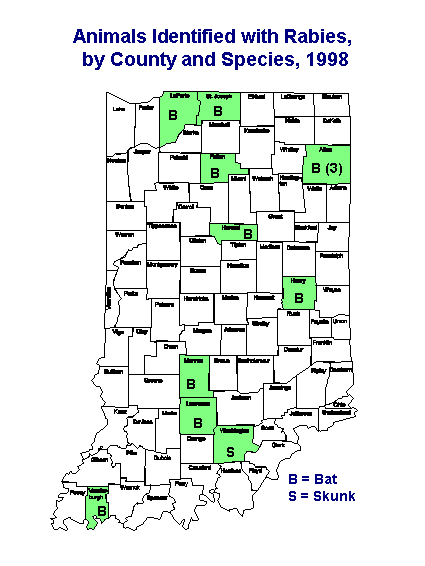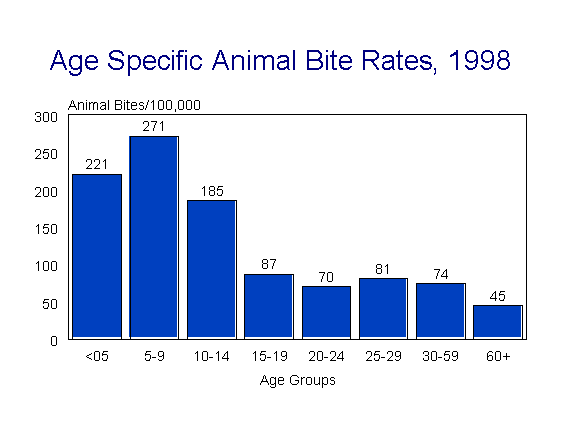
RABIES AND ANIMAL BITES
Rabies in Animals
Cases
= 12 (11 bats, 1 skunk)Indiana currently has two reservoirs of rabies virus: skunks and bats. Since 1990, there have been 6 skunks and 131 bats identified by the Indiana State Department of Health Disease Control Laboratory as rabies positive.
In 1998, the Laboratory tested 2,020 animals for rabies. The most frequently tested animals were dogs (787), cats (600), bats (195), and raccoons (160). Counties of origin for animals identified as rabid in 1998 are shown in Figure 1.
Figure 1.

Since 1962, skunks have been the primary reservoir of rabies in the state. Of the 1,639 animals diagnosed rabies positive since 1962, 53% have been skunks. However, there have only been 6 skunks diagnosed with rabies since 1990. The strain of skunk rabies found in Indiana is the same variant as that found in other north-central states. The surrounding states of Illinois, Ohio, and Kentucky also are part of this enzoonoses. Kentucky had 10 rabies positive skunks in 1998.
Bats have been the second most frequently identified animal with rabies since 1962 with
334 (20%) testing positive. In the past 10 years however, bats have become the most
commonly identified rabies positive species (152 positive specimens) accounting for 93% of
all positive animals during that time period. The importance of bat rabies must be
examined in the context of a national perspective. Since 1990, there have been twenty-two
human deaths due to rabies acquired in the United States. A bat variant rabies virus
caused twenty-one of the deaths. A history of a bite or other contact that could have
resulted in rabies transmission was not determined for most of these victims. As a result,
the Advisory Committee on Immunization Practices has made major changes in its
recommendations for evaluating contact or potential contact with an untested bat. Current
recommendations state that postexposure prophylaxis should be considered when direct
contact between a human and a bat has occurred, unless the exposed person can be certain a
bite, scratch, or mucous membrane exposure did not occur. In instances where a bat is
found indoors, postexposure prophylaxis can be considered for persons who were in the same
room as the bat and who might be unaware that a bite or direct contact had occurred. For
example, a sleeping person awakens to find a bat in the room or an adult witnesses a bat
in the room with a previously unattended child, mentally disabled person, or intoxicated
person, and rabies cannot be ruled out by testing the bat.
Animal Bites
Cases
= 7,206Age Distribution of Bite Victims
Figure 2.

Rabies Postexposure Prophylaxis
In 1998, there were 58 reported incidents where the circumstances of an animal bite or exposure resulted in a decision to administer postexposure immunization against rabies. The postexposure immunization series consists of an initial dose of human rabies immune globulin and 5 doses of rabies vaccine given on day 0, 3, 7, 14, and 28. Figure 4 presents the number of postexposure treatments required by species.
Figure 3.

Animal Vaccination Status
Rabies vaccination of domestic dogs and cats is the primary barrier to preventing exposure of humans to rabies. For this reason, Indiana State law requires annual rabies vaccination for both dogs and cats. From animal bite reports, which indicated the rabies vaccination status (yes, no, unknown) of biting animals, it is noted that 37% of dogs and 14% of cats had a current vaccination. Considering only those animals for which the vaccination status was known (i.e., yes or no), dogs had a vaccination rate of 65% and cats 39%.
[an error occurred while processing this directive]